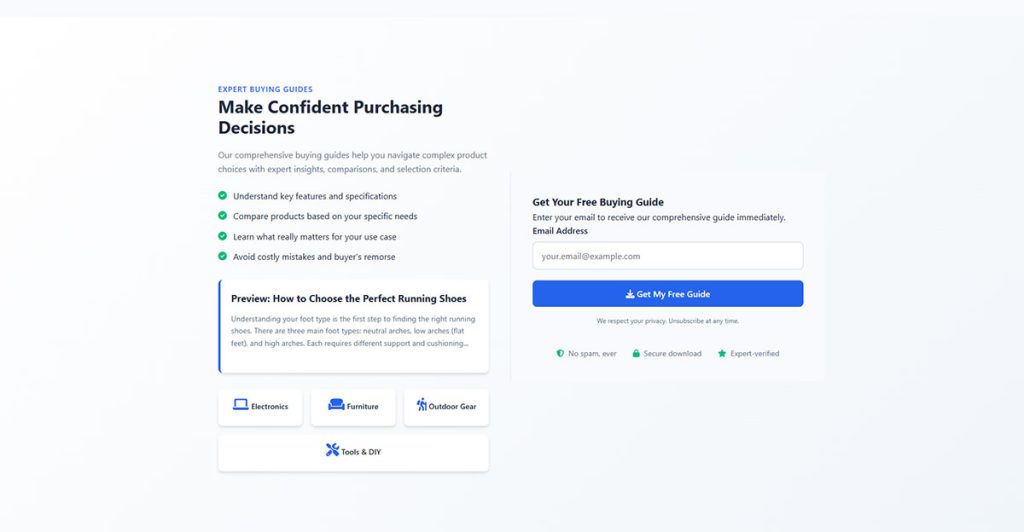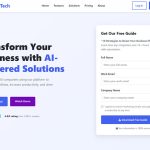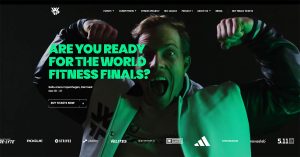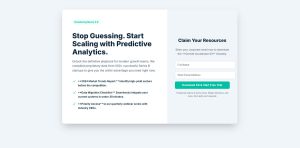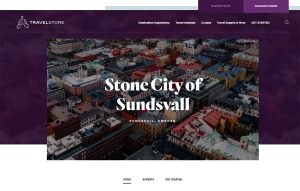Empty treadmills don’t pay bills. Fitness centers compete against Planet Fitness, Anytime Fitness, and boutique studios on every corner. Lead generation for gyms separates the survivors from the closures. The…
Table of Contents
Your online store gets traffic, but visitors leave without buying or subscribing. The gap between browsers and buyers costs you real money every single day.
Lead magnets for ecommerce solve this problem by giving visitors something valuable in exchange for their email addresses. Free shipping thresholds, discount codes, and product samples convert casual shoppers into trackable leads you can nurture into customers.
This guide covers 20 proven lead magnet strategies with actual conversion benchmarks, implementation requirements, and follow-up tactics. You’ll learn which magnets work best for different customer segments, how to optimize each type for maximum email capture, and what conversion rates to expect based on current ecommerce data.
Stop watching potential customers disappear. Start building your email list with magnets that actually convert.
Lead Magnets For Ecommerce
| Lead Magnet Type | Implementation Context | User Intent Match | Conversion Stage |
|---|---|---|---|
| Free Shipping Thresholds | Cart abandonment reduction mechanism with specific monetary value trigger | Transactional purchase intent with price sensitivity consideration | Decision stage conversion optimization |
| Discount Codes | Percentage-based or fixed-amount price reduction incentive | Value-seeking purchase behavior with promotional expectation | Immediate conversion catalyst |
| Product Samples | Physical product trial program for quality verification | Risk-averse evaluation behavior requiring tactile validation | Awareness to consideration transition |
| Buying Guides | Educational content resource for product category comprehension | Informational research intent with knowledge gap identification | Early consideration stage education |
| Size Charts | Dimensional specification tool for fit accuracy assurance | Technical specification verification for apparel purchase confidence | Pre-purchase validation checkpoint |
| Style Quizzes | Interactive preference assessment for personalized recommendation generation | Exploratory browsing behavior with personalization expectation | Discovery phase engagement |
| Email-Exclusive Deals | Subscriber-only promotional pricing with exclusivity positioning | Special access desire with VIP treatment psychological trigger | List building with repeat engagement |
| Early Access to Sales | Temporal priority advantage for inventory availability guarantee | Scarcity-driven purchase urgency with FOMO activation | Pre-sale conversion acceleration |
| Gift Guides | Curated product collection for occasion-specific gifting scenarios | Recipient-focused selection assistance with time-constrained decision | Seasonal consideration phase |
| Lookbooks | Visual merchandising collection showcasing product styling combinations | Aesthetic inspiration seeking with outfit coordination guidance | Brand affinity building phase |
| Trend Reports | Industry analysis document on emerging market patterns | Forward-looking awareness with early adopter mindset | Thought leadership positioning |
| Care Instructions | Post-purchase maintenance guide for product longevity maximization | Investment protection concern with usage optimization | Customer retention support |
| Product Comparison Charts | Feature-attribute matrix for specification-based evaluation | Analytical decision-making with feature prioritization requirement | Final decision facilitation |
| Wishlist Reminders | Saved item notification system with price drop alerts | Delayed purchase consideration with optimal timing monitoring | Re-engagement conversion path |
| Abandoned Cart Coupons | Recovery incentive for incomplete transaction completion | Purchase hesitation resolution with price objection handling | Lost conversion recovery |
| Loyalty Program Signups | Points-based rewards system for repeat purchase incentivization | Long-term relationship building with cumulative benefit expectation | Lifetime value development |
| Referral Rewards | Advocacy incentive program with mutual benefit structure | Social proof amplification with network expansion motivation | Customer acquisition multiplier |
| Product Bundles | Complementary item package with aggregated value proposition | Solution-oriented purchase with convenience optimization | Average order value increase |
| Limited Edition Items | Scarcity-positioned exclusive product with finite availability | Collector mentality with uniqueness value perception | Premium segment targeting |
| VIP Club Access | Tiered membership program with premium benefit allocation | Status recognition desire with exclusive privilege access | Brand loyalty cultivation |
Free Shipping Thresholds
A minimum purchase requirement that unlocks free delivery. Customers spend more to avoid shipping fees, which drives higher cart values without complex incentives.
Target Audience
Works across all customer segments but particularly effective for hesitant buyers at checkout. Best for stores with average order values between $35-$75 where customers can realistically add one or two items to qualify.
Value Proposition
Eliminates the #1 cart abandonment trigger. 48% of shoppers abandon carts specifically because of unexpected shipping costs, and 80% will add items to meet a free shipping minimum.
Implementation Requirements
Set threshold 20-30% above current average order value. Most stores set it between $50-$75. Requires clear shipping policy documentation and checkout messaging that shows how close customers are to qualifying.
No specialized tools needed. Just configure in Shopify, WooCommerce, or your platform’s settings.
Conversion Optimization
Display progress bars at cart showing “Add $12 more for free shipping!” Place threshold notifications on product pages and in cart. Use exit-intent popups reminding visitors about the free shipping benefit when they’re about to leave.
Red text for “Free Shipping” messaging increases visibility more than other colors.
Typical Conversion Rate
Stores offering free shipping see 20% higher conversion rates than those without. 58% of customers actively add products to qualify for the threshold, boosting average order value by $10-20 per transaction.
Follow-Up Strategy
Send abandoned cart emails highlighting that their cart is close to free shipping threshold. Include product recommendations that bridge the gap. Follow up 24 hours later with “Still thinking about it?” messaging that reinforces the free shipping benefit.
Discount Codes

Image source: pranaspring.ae
Percentage or dollar-amount reductions applied at checkout. The most straightforward lead magnet that directly incentivizes first purchases and email signups.
Target Audience
Perfect for first-time visitors and price-sensitive shoppers. Works particularly well for fashion, beauty, and consumer goods where discount expectations run high. Less effective for luxury brands where discounting erodes perceived value.
Value Proposition
Immediate, tangible savings that reduce purchase friction. 62% of online shoppers actively search for promo codes before completing purchases, and 84% have made a purchase specifically because of a discount offer.
Implementation Requirements
Determine sustainable discount level (typically 10-25%). Generate unique codes or use universal codes. Most effective discounts for email capture range from 10-20%.
Platforms like Klaviyo, Mailchimp, or OptinMonster handle code generation and popup forms automatically.
Conversion Optimization
Use exit-intent popups with “Get 15% off your first order!” messaging. Place opt-in forms prominently on homepage and product pages. A/B test different discount amounts (15% often converts better than 20% because it attracts more qualified buyers rather than pure bargain hunters).
Create urgency with expiration dates like “Valid for 48 hours.”
Typical Conversion Rate
Discount codes in email capture forms convert at 7-18% depending on offer value. Moderate discounts (10-25%) increase overall purchase conversion rates by 25-35% compared to non-discounted products. Coupon redemption rates average 7% or higher for digital codes.
Follow-Up Strategy
Send discount code immediately in welcome email. Trigger reminder at 24 hours if unused: “Don’t forget your 15% off expires tomorrow!” Follow with product recommendations featuring best-sellers. If code expires unused, send “Last chance” email 2 hours before expiration with potential bonus (“We extended your code by 24 hours”).
Product Samples
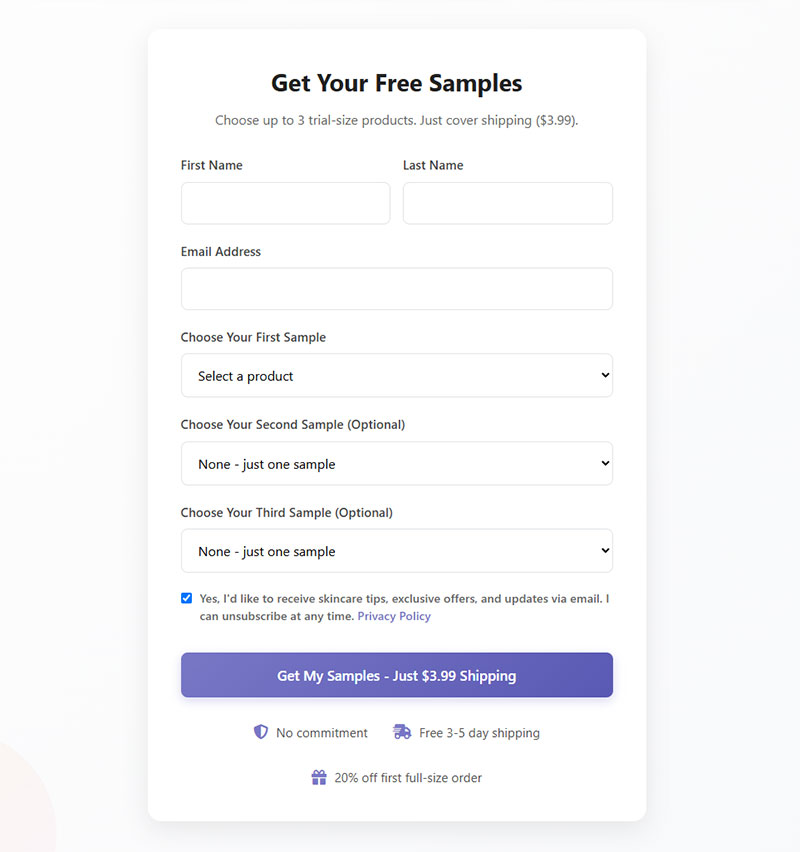
Free or low-cost trial-size versions of products. Lets customers test before committing to full-size purchases, reducing perceived risk for new-to-brand shoppers.
Target Audience
Beauty, skincare, food, and supplement brands. Best for products where experience drives conversion (texture, scent, taste). Targets quality-conscious buyers who need proof before investing in premium products.
Value Proposition
Risk-free trial that builds confidence and product attachment. Customers who try samples convert to full-price purchases at 40-60% rates. Creates brand loyalty through direct product experience.
Implementation Requirements
Source sample sizes or create mini versions. Calculate sustainable cost per sample including shipping. Require email signup or small shipping fee ($3-5) to offset costs and qualify leads.
Fulfillment takes same resources as regular orders but at smaller scale.
Conversion Optimization
Offer samples of best-sellers or new launches. Position as “Try before you buy” on product pages. Use language like “See if it’s right for you” rather than generic “free sample.”
Limit to one per customer to prevent abuse while encouraging broader audience reach.
Typical Conversion Rate
Sample request forms convert at 12-20% when positioned on product pages. Post-sample purchase conversion rates range from 40-60% within 30 days, significantly higher than cold email conversion.
Follow-Up Strategy
Ship sample with card explaining full product benefits and offering 20% off first full-size purchase. Email after 7 days: “How are you enjoying your sample?” with personalized recommendations. Follow at day 14 with limited-time offer to convert sample users to customers. Track who purchases after sampling to refine future offers.
Buying Guides
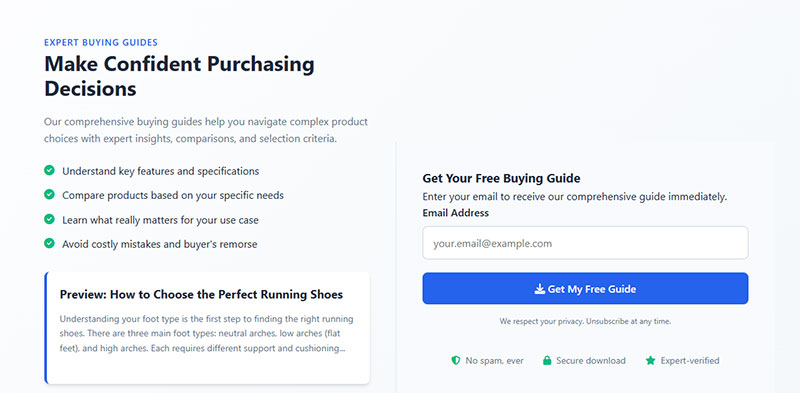
Comprehensive educational content helping customers choose the right product. Positions your brand as expert while addressing pre-purchase questions that slow conversion.
Target Audience
High-consideration categories like electronics, furniture, outdoor gear, and technical products. Serves customers early in purchase journey who need education before commitment. Works well for B2C and B2B audiences doing research.
Value Proposition
Reduces decision paralysis by explaining product differences, use cases, and features. Builds trust through education rather than hard selling. Customers who engage with buying guides show 30% higher purchase intent.
Implementation Requirements
Create detailed PDF or landing page covering product categories, comparisons, and selection criteria. Requires product knowledge and content creation skills. Gate behind email signup.
Time investment: 8-15 hours for comprehensive guide. Update quarterly as product lines change.
Conversion Optimization
Title guides for specific pain points: “How to Choose the Perfect Running Shoes for Your Foot Type” not “Running Shoe Guide.” Feature gated content prominently on category pages and in blog posts addressing product questions.
Preview first section before requiring email to demonstrate value.
Typical Conversion Rate
Buying guide opt-in forms convert at 8-15% depending on topic relevance. Leads who download guides convert to customers at 22-28% rates, higher than average email subscribers because they’re actively researching.
Follow-Up Strategy
Deliver guide immediately with message: “Here’s everything you need to know.” Email 3 days later highlighting specific products matching common use cases from guide. At day 7, share customer success stories for products featured in guide. Segment based on guide topic to personalize future recommendations.
Size Charts
Interactive tools helping customers find correct fit. Critical for apparel and footwear where fit uncertainty drives returns and cart abandonment.
Target Audience
Fashion, footwear, and apparel retailers. Serves international customers unfamiliar with sizing standards. Particularly valuable for brands with unique sizing or fit characteristics.
Value Proposition
Reduces return rates (which average 17.6% for online fashion) and increases purchase confidence. Customers who reference size charts convert at 15% higher rates than those who don’t. Email-gated advanced fit recommendations build loyalty.
Implementation Requirements
Basic charts require measurements for each size. Advanced versions use quiz format: “What’s your usual size in Brand X?” to recommend sizes in your products. Gate personalized recommendations behind email signup.
Build with simple forms or tools like Typeform. Update when sizing changes.
Conversion Optimization
Place size chart links prominently on all product pages. Offer “Get personalized size recommendations” form that asks 3-5 fit questions and requires email for results. Use language like “Find your perfect fit” to emphasize benefit over data collection.
Send recommendations as downloadable PDF customers can reference later.
Typical Conversion Rate
Basic size chart usage correlates with 15% conversion lift. Email-gated personalized sizing tools convert at 10-18%. Post-signup purchase rates increase 25% because customers feel confident about fit.
Follow-Up Strategy
Email size recommendations immediately with specific product suggestions in recommended size. Follow up 48 hours later: “Found something you love?” with curated picks. After 7 days, share fit tips and styling advice. Remind customers their size profile is saved for easier future shopping.
Style Quizzes
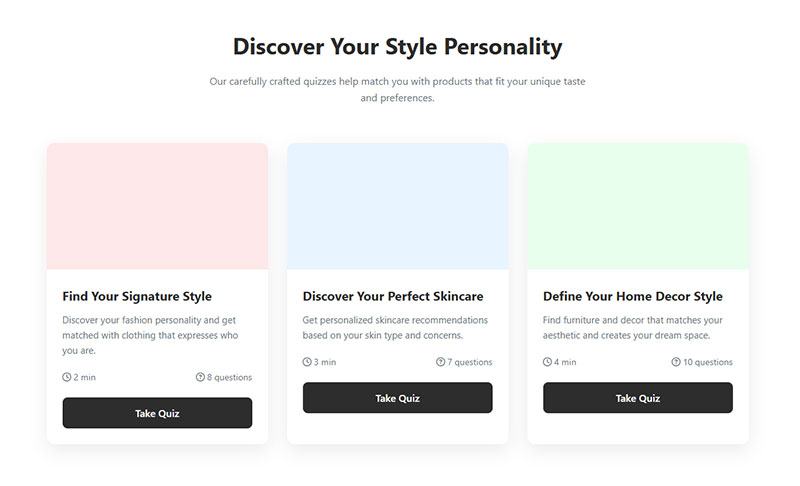
Interactive questionnaires that recommend products based on preferences and needs. Using quizzes for product matching creates personalized shopping experiences while capturing zero-party data.
Target Audience
Fashion, home decor, beauty, and lifestyle brands where personal taste drives purchases. Appeals to customers overwhelmed by choices or unfamiliar with your product range. Particularly effective for younger demographics (25-40) who expect personalization.
Value Proposition
Cuts through product overwhelm by delivering curated recommendations. Quizzes convert at 20-40% compared to passive content at 36%. Creates fun, engaging experience that feels helpful rather than sales-focused.
Implementation Requirements
Design 5-10 questions covering style preferences, use cases, and needs. Build with Typeform, Octane AI, or similar quiz platforms. Requires email to reveal results.
Initial setup: 10-15 hours. Connects to product catalog for dynamic recommendations.
Conversion Optimization
Title quiz for aspirational outcomes: “Find Your Signature Style” or “Discover Your Perfect Skincare Routine.” Keep questions visual and quick (under 2 minutes). Gate results behind email but show progress bar so users know they’re close to answers.
Share quiz on social media and in ads because interactive content drives engagement.
Typical Conversion Rate
Style quizzes convert at 25-35% for email capture. Post-quiz purchase conversion rates hit 15-25% because recommendations feel personalized and relevant. Quiz takers have 2-3x higher lifetime value than general email subscribers.
Follow-Up Strategy
Email results immediately with “Your Perfect Matches” and top 5 product recommendations. Send follow-up 3 days later featuring one highlighted product with social proof. At day 7, offer limited-time discount on quiz recommendations. Segment future emails based on quiz answers for hyper-personalized campaigns.
Email-Exclusive Deals

Special offers available only to email subscribers. Creates FOMO while building email list with high-intent shoppers.
Target Audience
Bargain hunters and deal-seekers across all demographics. Works for any product category. Most effective for customers who visit your site multiple times without purchasing, indicating price sensitivity.
Value Proposition
Makes subscribers feel like insiders getting special treatment. 80% of consumers sign up for emails specifically to receive discounts. Exclusive access creates perceived value beyond the discount itself.
Implementation Requirements
Develop ongoing calendar of subscriber-only promotions (weekly or monthly). Requires promotional planning and email marketing platform. Offers should be genuinely exclusive, not available elsewhere on site.
Minimal setup. Focus on maintaining exclusive nature to preserve value proposition.
Conversion Optimization
Use language emphasizing exclusivity: “Join VIP List for Members-Only Deals.” Display signup forms on high-traffic pages with current exclusive offer preview. Create urgency with limited-time access: “This Week’s Subscriber Deal.”
Highlight savings amount in concrete terms: “Save $25” rather than “Save 20%.”
Typical Conversion Rate
Exclusive deal signup forms convert at 12-20% depending on offer strength. Subscribers acquired through deal offers convert to purchases at 8-12% initially, with repeat purchase rates improving over time as relationship develops.
Follow-Up Strategy
Send weekly or bi-weekly exclusive deals. Alternate between percentage discounts, dollar amounts, and free gifts to maintain interest. Include expiration dates to drive urgency. Track which offers drive highest engagement and double down on those formats. After 30 days, send “You’ve saved $X as a subscriber” message to reinforce value.
Early Access to Sales
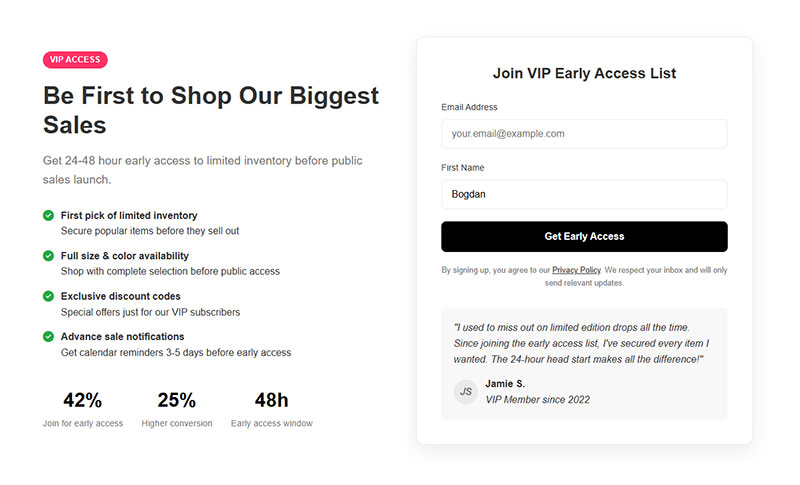
Advance notification and shopping windows before public sales launch. Rewards email subscribers with first pick of limited inventory and best selection.
Target Audience
Loyal customers and brand enthusiasts who don’t want to miss out on popular items. Particularly effective for limited-edition releases, seasonal sales, and high-demand products that sell out quickly.
Value Proposition
VIP treatment that makes subscribers feel valued and special. Guarantees first access to sales and full size/color availability. 42% of consumers will join loyalty programs specifically for early access benefits.
Implementation Requirements
Schedule sales with 24-48 hour early access window for email subscribers. Requires email segmentation to target subscriber list before public announcement. Use unique discount codes or private sale links.
Simple to implement through email platform’s scheduling features.
Conversion Optimization
Market early access aggressively in signup forms: “Be first to shop our biggest sale of the year.” Send advance notice 3-5 days before early access: “Mark your calendar.” Create excitement through countdown emails.
Make access genuinely exclusive by keeping sale private during early window.
Typical Conversion Rate
Early access signups convert at 18-25% when tied to anticipated sales events (Black Friday, new product launches). Conversion during early access windows runs 15-20% higher than public sale periods because of selection advantage and FOMO.
Follow-Up Strategy
Send early access invitation 24 hours before public sale with clear start time. Reminder 2 hours before access begins. During window, send “Last 6 hours of early access” message. After sale, thank subscribers and preview next exclusive opportunity to maintain engagement.
Gift Guides
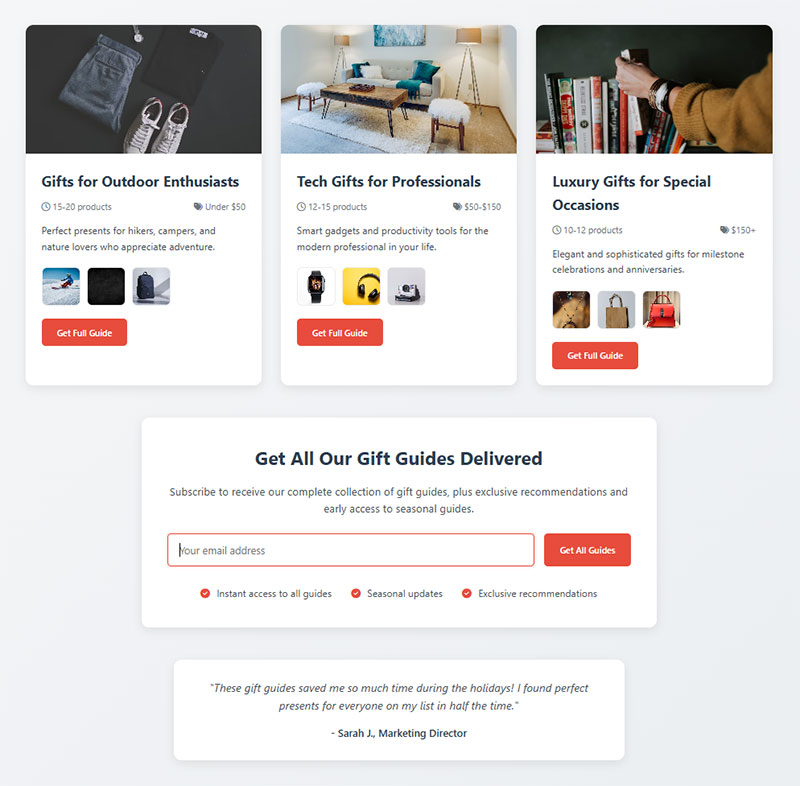
Curated product collections organized by recipient, occasion, or price point. Simplifies gift shopping while showcasing your product range.
Target Audience
Holiday shoppers and gift buyers throughout the year (birthdays, weddings, graduations). Serves time-pressed customers seeking inspiration and busy professionals outsourcing gift selection.
Value Proposition
Eliminates gift-shopping stress by providing ready-made suggestions. Increases average order value as customers discover complementary products. Gift guide engagement peaks November-December but performs year-round for occasions.
Implementation Requirements
Curate 10-20 products into themed collections. Create visual PDF or dedicated landing page. Update seasonally or quarterly. Gate behind email for “full guide with exclusive recommendations.”
Design time: 5-10 hours per guide. Leverage existing product photography.
Conversion Optimization
Create specific guides rather than generic: “Gifts for Outdoor Enthusiasts Under $50” not “Gift Guide.” Promote through social media, blog posts, and paid ads during peak gift-giving seasons. Offer free preview showing 3-4 items before requiring email.
Include direct purchase links from guide to reduce friction.
Typical Conversion Rate
Gift guide opt-ins convert at 10-16%. Shoppers who download guides purchase at 18-24% rates with 30% higher average order values because they’re buying multiple gifts. Peak conversion occurs October-December for holiday shopping.
Follow-Up Strategy
Deliver guide immediately. Email 2 days later highlighting top sellers from guide with social proof. Send reminder 5 days before major holidays: “Still need gifts?” with quick-ship options. Post-holiday, transition subscribers to general email nurture with focus on self-purchase products.
Lookbooks
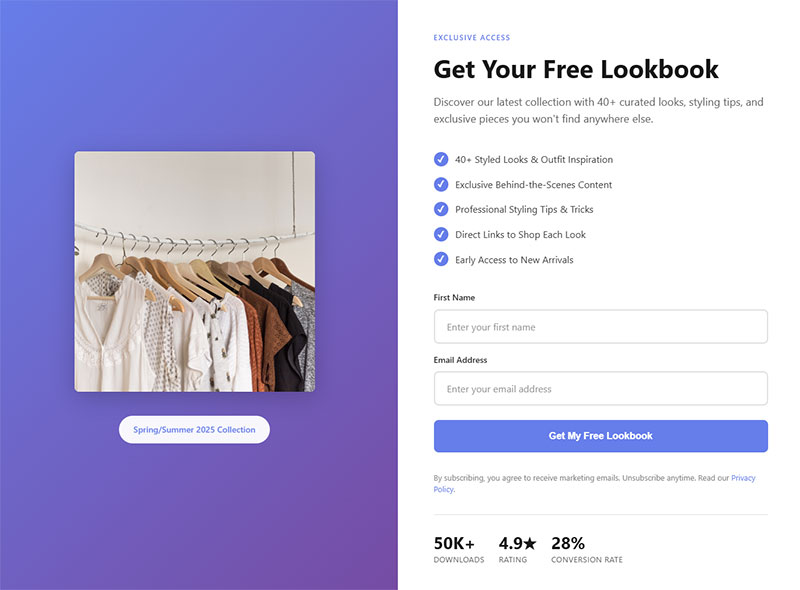
Visual catalogs showcasing products in styled contexts. Particularly powerful for fashion, home decor, and lifestyle brands where aspiration drives purchases.
Target Audience
Visual shoppers seeking inspiration and style guidance. Appeals to customers who need to see products in use before purchasing. Effective for Instagram-native audiences who consume content visually.
Value Proposition
Demonstrates how products work in real life rather than isolated product shots. Inspires aspirational purchases through styled imagery. Lookbooks create emotional connection that drives 20% higher engagement than standard product catalogs.
Implementation Requirements
Professional photography showing products in styled environments or outfits. Design multi-page PDF or interactive landing page. Requires creative direction and photography investment. Gate behind email signup.
Production time: 15-30 hours depending on complexity. Seasonal updates recommended.
Conversion Optimization
Promote lookbooks on Instagram and Pinterest where visual content performs best. Use landing pages with hero images from lookbook and “Get the Full Collection” call-to-action. Include shoppable elements in digital versions linking directly to products.
Preview 3-5 pages to demonstrate quality before requiring email.
Typical Conversion Rate
Lookbook signup forms convert at 12-18%. Subscribers who download lookbooks purchase at 20-28% rates because visual inspiration drives emotional buying decisions. Products featured in lookbooks see 25-40% sales lifts during campaign periods.
Follow-Up Strategy
Send lookbook immediately with message about this season’s key trends. Email 3 days later featuring most popular looks with direct purchase links. Share behind-the-scenes content or styling tips 7 days later. Segment based on products they clicked within lookbook for personalized recommendations.
Trend Reports
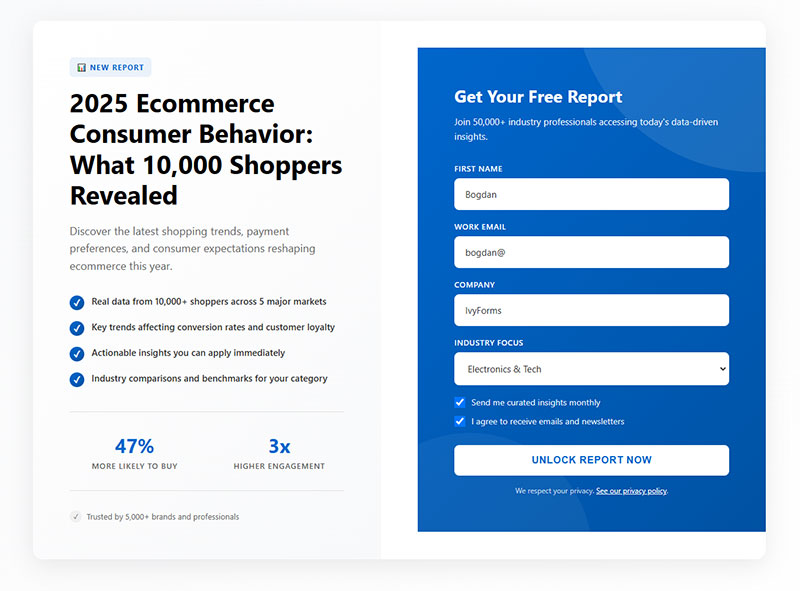
Data-driven insights about industry trends, consumer behavior, or market forecasts. Positions brand as thought leader while providing genuine value beyond products.
Target Audience
B2B buyers, industry professionals, and informed consumers who value data and expertise. Particularly effective for professional categories (business software, industrial supplies) and premium consumer markets where knowledge signals quality.
Value Proposition
Educational content that serves audience beyond immediate purchase intent. Builds authority and trust. Subscribers who engage with thought leadership content show 35% higher customer lifetime value because they view brand as expert resource.
Implementation Requirements
Research industry data, compile statistics, add expert analysis. Create professional PDF or webinar registration forms for live trend presentations. Requires subject matter expertise and research capabilities.
Time investment: 20-40 hours per report. Annual or quarterly releases typical.
Conversion Optimization
Title for specific insights: “2025 Ecommerce Consumer Behavior: What 10,000 Shoppers Revealed” not “Ecommerce Trends.” Promote through LinkedIn and industry publications. Include data visualizations in promotional materials to demonstrate value.
Excerpt key statistics in blog posts and social media to drive traffic to gated full report.
Typical Conversion Rate
Trend report opt-ins convert at 8-14% because audience is more niche and qualified. Conversion to purchase happens over longer timeframe (30-90 days) but at higher rates (25-35%) with significantly higher average order values.
Follow-Up Strategy
Deliver report immediately. Send follow-up 5 days later highlighting key takeaway with application to customer needs: “How this trend affects your business.” Share related content (blog posts, case studies) over next 30 days. Transition to product-focused emails showing how your offerings align with identified trends.
Care Instructions
Detailed guides for maintaining, cleaning, or using products properly. Demonstrates post-purchase support while capturing leads from existing customers and researchers.
Target Audience
Current customers seeking product longevity and prospects researching product requirements before purchase. Valuable for technical products, luxury items, and purchases requiring ongoing maintenance (furniture, appliances, outdoor gear).
Value Proposition
Extends product lifespan and improves satisfaction. Positions brand as supportive and expert. Customers who access care information show 40% lower return rates and 50% higher repeat purchase rates.
Implementation Requirements
Document proper care, maintenance, troubleshooting for each product category. Create downloadable PDFs or video tutorials. Offer advanced care tips in exchange for email signup.
Time per guide: 3-5 hours. Update when products change or common questions emerge.
Conversion Optimization
Promote care guides on product pages and in post-purchase emails. Use headlines addressing specific concerns: “Keep Your Leather Sofa Looking New for Years.” Offer basic care tips freely with advanced guide gated: “Get our complete maintenance schedule.”
Video format performs 30% better than text for care instructions.
Typical Conversion Rate
Care guide opt-ins convert at 6-12%. Leads acquired through care content have 60% higher repeat purchase rates because ongoing engagement maintains brand awareness. Cross-sell opportunities emerge naturally from maintenance discussions.
Follow-Up Strategy
Send guide immediately. Email 30 days later: “How’s your [product] holding up?” with additional care tips and complementary product suggestions (leather conditioner for furniture, specialized cleaners, accessories). Use care guides as touchpoint for re-engagement campaigns targeting past customers.
Product Comparison Charts
Side-by-side feature and pricing comparisons helping customers choose between options. Reduces decision fatigue in categories with multiple similar products.
Target Audience
Analytical buyers who research thoroughly before purchasing. Common in electronics, software, appliances, and any category with multiple product tiers or versions. Serves customers in middle-to-late purchase journey.
Value Proposition
Simplifies complex decisions by highlighting key differences. Prevents analysis paralysis that causes cart abandonment. Comparison chart users convert at 25% higher rates than those who don’t access comparisons.
Implementation Requirements
Create tables or interactive tools comparing products across key features, specs, and prices. Gate advanced comparison tools or personalized recommendations behind email. Update when products change.
Build with basic spreadsheet converted to PDF or interactive web tool. Time: 4-8 hours initially.
Conversion Optimization
Place comparison charts on category pages and in product descriptions. Offer “Get personalized recommendation based on your needs” requiring email and 3-5 qualification questions. Make charts mobile-friendly because 55% of comparison research happens on phones.
Highlight “most popular” or “best value” options to guide decisions.
Typical Conversion Rate
Comparison chart opt-ins convert at 14-20% for complex product categories. Post-comparison conversion rates jump 25-30% because clarity reduces purchase hesitation. Average order values increase 15% as customers feel confident choosing higher-tier products.
Follow-Up Strategy
Send comparison chart immediately with specific recommendation based on submitted preferences. Email 2 days later featuring recommended product with customer reviews. Share limited-time offer 5 days later: “Still deciding? Here’s 10% off to help you choose.” Follow purchase with education on maximizing chosen product.
Wishlist Reminders
Email notifications when saved products go on sale or low stock. Captures emails while demonstrating value through active price monitoring.
Target Audience
Browsers and researchers who aren’t ready to purchase immediately. Price-sensitive shoppers waiting for deals. Window shoppers who need time to decide or justify purchases.
Value Proposition
Never miss sales on wanted items. Removes burden of manual price checking. 68% of shoppers have wishlists they check periodically, but only 15% remember to monitor prices actively.
Implementation Requirements
Wishlist functionality with email notification system. Requires platform capability to track price changes and inventory levels. Mandate email to save items for later access.
Most ecommerce platforms include wishlist features. Configure email triggers for price drops and low inventory alerts.
Conversion Optimization
Prompt visitors to “Save for later” or “Add to wishlist” on product pages. Require email to save: “Enter email to access your wishlist from any device.” Send immediate notification when saved items go on sale to create urgency.
Display number of people who’ve wishlisted product to add social proof.
Typical Conversion Rate
Wishlist signup converts at 18-25% because value proposition is clear and immediate. Wishlist members convert to purchases at 15-20% over 60 days, with conversion spikes during sale events.
Follow-Up Strategy
Send weekly “Wishlist update” showing price changes, low stock alerts, and similar products on sale. Create urgency when saved items have limited inventory: “Only 3 left in your size!” Send personalized sale alerts immediately when wishlisted products get discounted. Re-engage inactive wishlist users quarterly with broad sale announcements.
Abandoned Cart Coupons
Discount codes sent to shoppers who leave without purchasing. Recovers lost revenue while capturing emails from engaged visitors.
Target Audience
High-intent shoppers who added products to cart but didn’t complete checkout. Includes price-sensitive customers seeking better deals and distracted shoppers who need reminder nudge.
Value Proposition
Second chance to convert after initial hesitation. 48% of abandoned carts result from unexpected costs; strategic discount can overcome this objection. Abandoned cart emails recover 10-15% of lost sales.
Implementation Requirements
Abandoned cart email sequence with discount incentive. Requires email capture before or during cart building. Use exit-intent forms to capture emails from abandoners.
Platforms like Klaviyo, Omnisend, or Shopify email automate cart recovery sequences.
Conversion Optimization
Trigger first email within 1 hour of abandonment with gentle reminder. Send discount code 24 hours later if no purchase: “Complete your order and save 10%.” Use dynamic content showing exact items left behind with direct “Complete Purchase” link.
Test different discount levels (10% vs 15%) to find optimal conversion without margin erosion.
Typical Conversion Rate
Abandoned cart emails convert at 8-12% without discount incentive. Adding time-limited discount pushes conversion to 15-25%. Overall cart recovery rates improve 40-60% with strategic discount offers.
Follow-Up Strategy
Send three-email sequence: (1) 1 hour after abandonment – reminder only, (2) 24 hours later – add 10-15% discount, (3) 48-72 hours – final reminder with expiring discount. Include customer reviews and “Need help deciding?” messaging. Track which sequence point drives most conversions to optimize timing.
Loyalty Program Signups
Points-based or tiered programs rewarding repeat purchases. Captures emails while creating long-term customer retention mechanism.
Target Audience
Repeat customers and brand enthusiasts who shop frequently enough to accumulate meaningful rewards. Best for consumable products, fashion, and categories with natural repeat purchase cycles.
Value Proposition
Earn rewards for purchases you’d make anyway. Members-only perks create VIP feeling. Loyalty program members spend 12-18% more per transaction and have 60-70% higher retention rates than non-members.
Implementation Requirements
Define reward structure (points per dollar, redemption thresholds). Choose between points-based, tiered, or spend-based programs. Requires loyalty platform (Smile.io, LoyaltyLion, Yotpo) integration with email system.
Setup time: 10-15 hours. Ongoing management for reward fulfillment and tier tracking.
Conversion Optimization
Highlight immediate signup bonus: “Join now and get 500 points ($5 value).” Display points-earning potential on product pages: “Earn 50 points with this purchase.” Show program benefits prominently in header or footer.
Make signup simple (just email and password) to reduce friction.
Typical Conversion Rate
Loyalty program signup forms convert at 15-25% when clearly communicating immediate benefits. Members convert at 60-70% repeat purchase rates versus 25-30% for non-members. Average order value increases 12-18% among active program participants.
Follow-Up Strategy
Send welcome email explaining how to earn and redeem points. Email when they’ve earned enough for first reward: “You have $10 to spend!” Send monthly points balance updates. Create FOMO with limited-time double-points promotions. Notify when approaching new tier: “Spend $25 more to reach Silver status!”
Referral Rewards
Incentives for customers who refer friends. Turns existing customers into acquisition channel while growing email list with pre-qualified leads.
Target Audience
Satisfied customers willing to vouch for your brand. Works best after positive purchase experience. Both referrer and referred friend become engaged email subscribers through program.
Value Proposition
Mutual benefit: existing customers earn rewards, new customers get deals. 83% of satisfied customers willing to refer, but only 29% actually do without incentive structure. Referred customers have 16% higher lifetime value.
Implementation Requirements
Referral tracking system providing unique links or codes per customer. Define reward structure (both parties get $10, or give $10 get $10). Platforms like ReferralCandy, Smile.io automate tracking and reward fulfillment.
Requires email collection from both referrer and referred to complete transaction.
Conversion Optimization
Promote program post-purchase when satisfaction peaks. Make sharing effortless with pre-written messages and one-click social sharing. Offer compelling incentives for both parties: “Give friends $15, get $15 when they purchase.”
Display referral earnings in customer accounts to maintain awareness.
Typical Conversion Rate
Referral program enrollments convert at 12-18% among existing customers. Referred friends convert at 15-25% higher rates than cold traffic because of social proof and incentive combination. Active referrers generate average 2-3 new customers annually.
Follow-Up Strategy
Send welcome email explaining how referrals work with personalized referral link. Email periodic reminders: “Share your link and earn $15.” Notify immediately when friend makes purchase: “You earned $15!” Create urgency with limited-time bonus rewards: “Refer 3 friends this month and get extra $20.”
Product Bundles
Curated sets of complementary products at package pricing. Increases average order value while simplifying multi-product purchases.
Target Audience
Customers seeking complete solutions or gift sets. New customers unfamiliar with product range who appreciate curated guidance. Bargain shoppers attracted to bundle savings.
Value Proposition
Convenience of ready-made sets plus cost savings (typically 10-20% off individual prices). Removes decision fatigue from choosing complementary items. Bundles increase average order value 30-50% compared to single-item purchases.
Implementation Requirements
Identify naturally complementary products. Create bundle landing pages with clear savings messaging. Price bundles 10-20% below combined individual prices. Gate “personalized bundle builder” tools behind email.
Time to create 5-10 bundles: 8-12 hours. Refresh seasonally.
Conversion Optimization
Highlight savings prominently: “Save $25 when you buy the complete set.” Create urgency with limited-edition bundles. Offer “Build your own bundle” tools requiring email for custom recommendations.
Feature bundles prominently during gift-giving seasons when set purchases peak.
Typical Conversion Rate
Bundle product pages convert at 8-15%, higher than individual product pages because simplified decision-making reduces friction. Email-gated bundle builders convert at 14-20%. Average order values for bundle purchases run 30-50% higher than single-item orders.
Follow-Up Strategy
Send bundle recommendations based on recent purchases: “Complete your collection with these items.” Email seasonal bundle offerings to existing customers. Offer loyalty members early access to limited-edition bundles. Create FOMO with countdown timers on holiday bundle availability.
Limited Edition Items
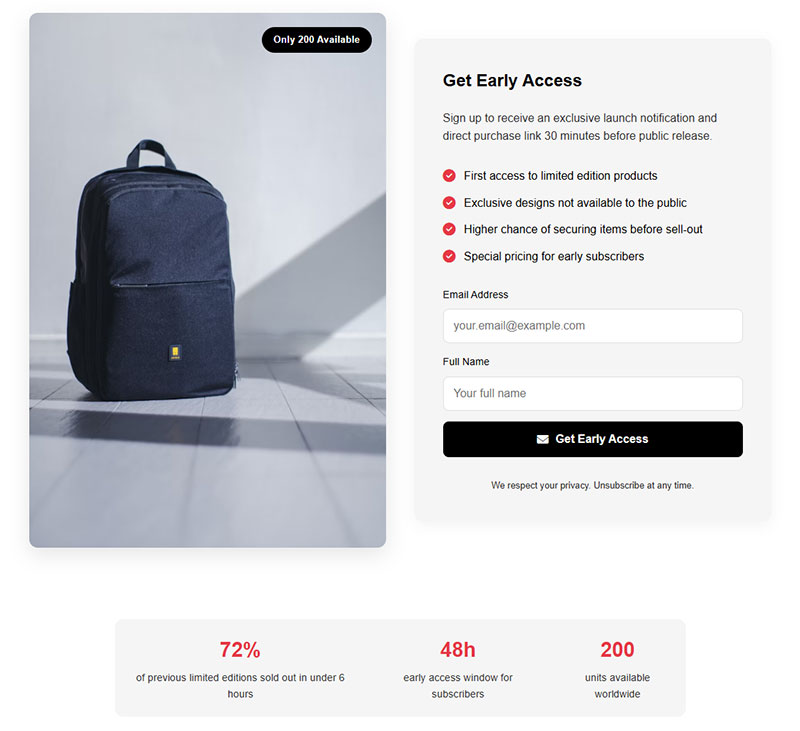
Exclusive, time-limited products creating scarcity and urgency. Captures emails from enthusiasts who don’t want to miss exclusive releases.
Target Audience
Brand loyalists, collectors, and early adopters who value exclusivity. Particularly effective for fashion, collectibles, and brands with strong community followings.
Value Proposition
Access to products unavailable to general public. Collectibility and uniqueness appeal to customers seeking differentiation. Scarcity creates urgency that drives 40-50% higher conversion rates than regular products.
Implementation Requirements
Develop limited production runs or exclusive colorways/designs. Create dedicated landing pages emphasizing scarcity. Require email signup for launch notifications.
Production planning depends on category. Marketing setup: 5-8 hours per launch.
Conversion Optimization
Build anticipation with “Coming soon” landing pages collecting emails. Send countdown emails to subscribers: “48 hours until launch.” Use specific scarcity messaging: “Only 200 available” not “Limited quantities.”
Create urgency but maintain brand integrity (avoid fake scarcity).
Typical Conversion Rate
Limited edition launch emails convert at 25-40% among interested subscribers because urgency and scarcity drive immediate action. Launch day conversion rates spike 3-5x normal levels. Products typically sell out in hours to days depending on production volume.
Follow-Up Strategy
Send launch announcement at exact time with direct purchase link. Email sellout notification to late arrivers: “Sold out in 6 hours! Join waitlist for next release.” Survey non-buyers about why they didn’t purchase to improve future launches. Tease next limited release to maintain engagement.
VIP Club Access
Tiered membership providing exclusive benefits, early access, and special pricing. Creates ongoing engagement while segmenting most valuable customers.
Target Audience
High-value repeat customers and brand enthusiasts willing to commit. Works best for brands with passionate communities and frequent new releases (fashion, beauty, collectibles).
Value Proposition
Insider status with tangible benefits like free shipping, exclusive products, early sale access, and special events. VIP members typically spend 2-3x more annually than regular customers.
Implementation Requirements
Define membership tiers and benefits for each level. Options include paid memberships (annual fee) or spend-based tiers (silver/gold/platinum based on annual spending). Requires ongoing benefit delivery and member communication.
Setup time: 15-25 hours for structure and platform integration.
Conversion Optimization
Clearly communicate benefits: “Free shipping, early access to sales, and members-only products.” Offer first month or year free to reduce signup friction. Display VIP benefits on high-traffic pages and during checkout: “VIP members save $7 on shipping.”
Make application exclusive: “Invite only” or “Spend $500 to qualify” increases perceived value.
Typical Conversion Rate
VIP club signups convert at 10-18% depending on barrier to entry. Free trials convert higher (15-18%) while paid memberships sit at 8-12%. VIP members maintain 60-75% annual retention rates and generate 2-3x revenue per customer compared to non-members.
Follow-Up Strategy
Send welcome package explaining all benefits and how to maximize membership. Email monthly highlighting exclusive perks they haven’t used yet. Create FOMO with “VIP-only” product launches and flash sales. Track engagement and reach out personally to inactive members. At renewal time, show total savings accumulated through membership to justify continuation.
FAQ on Lead Magnets For Ecommerce
What conversion rate should I expect from ecommerce lead magnets?
Average conversion rates vary by type. Discount code popups convert at 7-18%, while style quizzes hit 25-35%.
Free shipping thresholds and exclusive deals typically achieve 12-20% opt-in rates. Interactive content like product recommendation quizzes outperforms passive offers by 70%. Your actual results depend on offer value, audience targeting, and placement strategy.
How much discount should I offer to capture emails?
Moderate discounts between 10-20% work best for email list building. Research shows 15% converts better than 20% because it attracts qualified buyers rather than bargain hunters.
Test different amounts for your audience. Fashion and beauty brands typically succeed with 15-20%, while electronics and home goods perform well at 10-15%. Avoid discounting so deep you erode margins or train customers to wait for deals.
Should I use popup forms or inline forms for lead magnets?
Both work, but exit-intent popups capture abandoning visitors without disrupting browsing. They convert at 2-4% on average.
Inline forms embedded in content perform better for engagement (8-12%) but reach fewer visitors. Use exit-intent for discount offers and inline forms for educational content like buying guides. Test timing and frequency to avoid annoying repeat visitors.
What’s the best free shipping threshold to increase conversions?
Set your threshold 20-30% above current average order value. Most stores land between $50-$75 based on 2025 data.
80% of shoppers will add items to meet free shipping minimums. Calculate your average shipping cost, then set the threshold high enough to cover it while remaining achievable. Monitor checkout-to-purchase rates to ensure the threshold isn’t causing abandonment.
How do I follow up after someone downloads my lead magnet?
Send the promised content immediately in your welcome email. Follow up 2-3 days later with related product recommendations based on their interest.
Create segmented email sequences matching the lead magnet type. Quiz takers get personalized suggestions, guide downloaders receive implementation tips, and discount code recipients get reminder emails before expiration. Avoid generic blasts that ignore why they signed up.
Which lead magnets work best for first-time visitors?
Discount codes and free shipping offers convert cold traffic effectively because the value is immediate and clear.
Product samples work well for beauty and food brands where trial drives purchase decisions. Avoid complex lead magnets like trend reports for first-time visitors since they lack brand relationship. Save those for existing customers who already trust you.
How can I reduce my email list unsubscribe rate?
Deliver exactly what you promised when they signed up. If they opted in for a style quiz, don’t immediately blast them with daily sales emails.
Segment your list based on lead magnet type and send relevant content. Quiz takers want personalized recommendations, not generic promotions. Survey subscribers to understand preferences, then adjust frequency and content accordingly. Quality beats quantity for email marketing campaigns.
Do lead magnets work for B2B ecommerce stores?
Absolutely. Buying guides, trend reports, and product comparison charts perform exceptionally well for B2B audiences researching complex purchases.
Webinar registration and gated content like industry reports convert at 15-25% for business buyers. These leads have longer sales cycles but higher average order values. Focus on educational content demonstrating expertise rather than discount-driven offers that work for B2C.
How do I make my lead magnets GDPR compliant?
Use clear opt-in language explaining exactly what subscribers receive. Include checkboxes for consent rather than pre-checked boxes.
Link to your privacy policy on all signup forms. Explain how you’ll use their data and provide easy unsubscribe options in every email. Store consent records and honor data deletion requests. Klaviyo, Mailchimp, and similar platforms include built-in compliance features.
Should I gate all my content or offer some freely?
Offer basic information freely, then gate advanced or personalized content. This builds trust before asking for emails.
Preview your buying guide’s first section before requiring signup. Show three gift recommendations, then gate the full list of twenty. The teaser demonstrates value, making visitors more willing to exchange contact information. Balance lead generation with providing genuine help.
Conclusion
Implementing lead magnets for ecommerce transforms anonymous browsers into trackable prospects you can nurture through email marketing campaigns. The difference between guessing what visitors want and knowing exactly who’s interested in your products changes everything.
Start with one or two strategies that match your customer base. Free shipping thresholds work universally, while product-specific magnets like style quizzes or buying guides serve particular niches better.
Track your opt-in rates and abandoned cart recovery metrics obsessively. A/B test different discount amounts, form placements, and follow-up sequences until you find what resonates with your audience.
Your email list becomes your most valuable asset when built with qualified subscribers who actually want to hear from you. These aren’t random contacts bought from sketchy vendors or scraped from directories.
They’re real people who raised their hands and said they’re interested in what you sell. That’s worth more than any paid advertising campaign because the customer relationship starts with permission, not interruption.
Build your list strategically, and revenue follows naturally.
